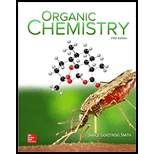
Concept explainers
Haloethanes
Want to see the full answer?
Check out a sample textbook solution
Chapter 4 Solutions
ORGANIC CHEMISTRY-MOLYMOD PACKAGE
Additional Science Textbook Solutions
Thermodynamics, Statistical Thermodynamics, & Kinetics
Chemistry: Matter and Change
General, Organic, and Biological Chemistry - 4th edition
Chemistry & Chemical Reactivity
CHEMISTRY-TEXT
Organic Chemistry - Standalone book
- 11. Which statement is true of the carbon-carbon bonds in benzene? (a) They are identical to the carbon-carbon bonds in cyclohexane. (b) They are identical to the carbon-carbon bonds in cyclohexene. (c) They are half-way between a double and single bond. (d) They are easily broken in chemical reactions. (e) They are all double bonds. ct Copyright O 2002 McGraw-Hill Ryerson Limited Name: Class:arrow_forwardIs isomerization of cis and trans 1,2-dichlorocyclopentane possible at room temperature? Explainarrow_forward2NaOH(a)+CaCl2(s)+2NaCl(s)arrow_forward
- The average bond energy (enthalpy) for a C=CC=C double bond is 614 kJ/molkJ/mol and that of a C−CC−C single bond is 348 kJ/molkJ/mol. Estimate the energy needed to break only the ππ bond of the double bond of 2-butene. Express your answer numerically in joules per molecule.arrow_forwardIn what way(s) is(are) the structure of H2O similar to that of CHCl3? In what way is the structure of water different from that of CHCl3?arrow_forwardArrange the following alkyl halides in order of increasing boiling point:(CH 3)3Br, (CH 3)2CH C(CH3) 2Br, (CH 3) 2CHBr, CH 3CH 2F.arrow_forward
- Predict the approximate values for the H¬O¬C and O¬C¬C bond angles in vinyl alcohol?arrow_forwardMany reactions involve a change in hybridization of one or more atoms in the starting material. In following reaction, identify the atoms in the organic starting material that change hybridization and indicate the change.arrow_forwardThe bond requires a larger amount of energy to rotate compared to the C—C bond in butane. What is the best explanation for this?arrow_forward
- 2arrow_forwardAlcohols A, B, and C all have the composition C4H10O. Molecules of alcohol A contain a branched carbon chain and can be oxidized to an aldehyde; molecules of alcohol B contain a linear carbon chain and can be oxidizedto a ketone; and molecules of alcohol C can be oxidized to neither an aldehyde nor a ketone. Write the Lewis structures of these molecules.arrow_forwardOne component of jojoba oil is a wax formed from eicosenoic acid [CH3(CH2)7CH=CH(CH2)9CO2H] and CH3(CH2)7CH=CH(CH2)8OH. Draw the structure of the wax, including the cis geometry of both carbon–carbon double bonds.arrow_forward
 Introductory Chemistry: A FoundationChemistryISBN:9781337399425Author:Steven S. Zumdahl, Donald J. DeCostePublisher:Cengage Learning
Introductory Chemistry: A FoundationChemistryISBN:9781337399425Author:Steven S. Zumdahl, Donald J. DeCostePublisher:Cengage Learning Chemistry & Chemical ReactivityChemistryISBN:9781337399074Author:John C. Kotz, Paul M. Treichel, John Townsend, David TreichelPublisher:Cengage Learning
Chemistry & Chemical ReactivityChemistryISBN:9781337399074Author:John C. Kotz, Paul M. Treichel, John Townsend, David TreichelPublisher:Cengage Learning Chemistry & Chemical ReactivityChemistryISBN:9781133949640Author:John C. Kotz, Paul M. Treichel, John Townsend, David TreichelPublisher:Cengage Learning
Chemistry & Chemical ReactivityChemistryISBN:9781133949640Author:John C. Kotz, Paul M. Treichel, John Townsend, David TreichelPublisher:Cengage Learning Chemistry: The Molecular ScienceChemistryISBN:9781285199047Author:John W. Moore, Conrad L. StanitskiPublisher:Cengage Learning
Chemistry: The Molecular ScienceChemistryISBN:9781285199047Author:John W. Moore, Conrad L. StanitskiPublisher:Cengage Learning Organic Chemistry: A Guided InquiryChemistryISBN:9780618974122Author:Andrei StraumanisPublisher:Cengage Learning
Organic Chemistry: A Guided InquiryChemistryISBN:9780618974122Author:Andrei StraumanisPublisher:Cengage Learning Chemistry: Principles and ReactionsChemistryISBN:9781305079373Author:William L. Masterton, Cecile N. HurleyPublisher:Cengage Learning
Chemistry: Principles and ReactionsChemistryISBN:9781305079373Author:William L. Masterton, Cecile N. HurleyPublisher:Cengage Learning





